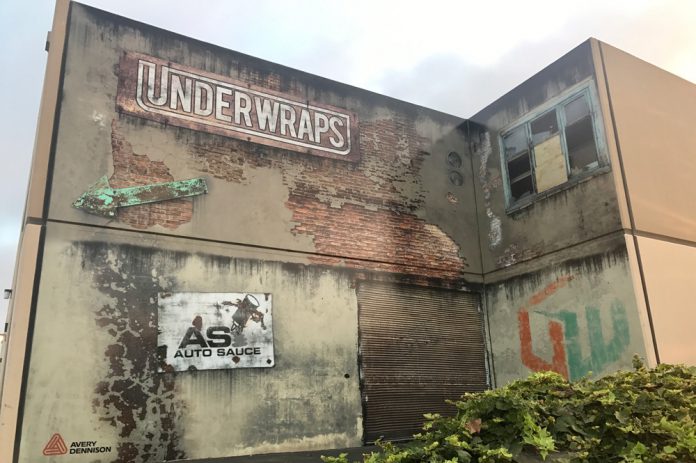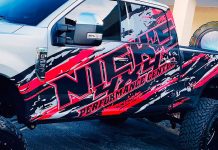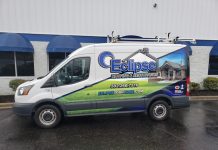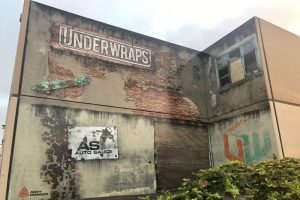 When you’re in the business of wrapping the world with digitally printed graphics, you might as well show off what you can do. “Opportunities in this business are everywhere,” says Tamara Baumann, owner and founder of Underwraps in Huntington Beach, California. “You can wrap pretty much anything—vehicles, walls, floors, furniture, ceilings, buildings, etc. And, the sky is the limit when it comes to design.”
When you’re in the business of wrapping the world with digitally printed graphics, you might as well show off what you can do. “Opportunities in this business are everywhere,” says Tamara Baumann, owner and founder of Underwraps in Huntington Beach, California. “You can wrap pretty much anything—vehicles, walls, floors, furniture, ceilings, buildings, etc. And, the sky is the limit when it comes to design.”
Over the course of her career, Baumann has had a hand in wrapping everything from a Steinway piano for Lady Gaga to boats, helicopters, and building interiors.
Her main focus is vehicle graphics, and Baumann estimates she’s helped restore, upgrade, and update the look of hundreds of cars and trucks.
Baumann launched Underwraps in 2016 as a one-stop shop for anyone eager to customize a vehicle inside or out. “When I first got started, people were just excited they could put a design on their car,” she says. “Today they want it to look like paint with a lot of attention to details so you can’t tell it’s been wrapped.”
Visitors to the industrial park where Underwraps is based are greeted by a highly visible example of the required design and installation expertise for quality wraps.
Among the streets of drab concrete buildings, the Underwraps headquarters stands out as dramatically different. A recent wall wrap on the outside of the building seems to situate it in another place, camouflaging the exterior in what you’d expect to encounter in some timeworn corner of an inner city factory district.
Details Make The Design
“I’ve always been a fan of cool architecture and especially urban, industrial spaces that have character written all over them,” says Baumann, who explains her company’s attention to detail is “extreme” and that they wanted to portray the same elements here to “wow” everyone.
This old look for the new building projects the authenticity of a sooty, neglected commercial district: weathered signs announcing the location, sections of brick showing through worn layers of peeling stucco, haphazardly repaired broken windows, and a rusted garage grate.
“When you’re driving through a modern industrial neighborhood like this, everywhere you look it’s the same brown and tan buildings,” says Baumann. “We wanted something different that would stand out. We’re definitely fans of that distressed look.”
The design concept is built on a trend she’s helped promote in her years wrapping custom cars and trucks.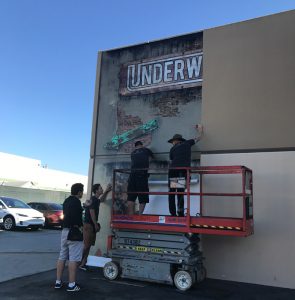
While most wraps entail dramatic graphics and bold colors, some owners have bucked these trends with calls for something more gritty and retro. Baumann says some hot-rodders would seek out vintage cars and trucks languishing in barns or sheds, update the motors and interiors, but leave the rusted exterior as is.
In 2013, Baumann bought a classic Chevy C10 pick-up with similar intentions then decided to make it a showcase example of what’s possible with digitally printed graphics. “We wanted to show what you can do by creating a wrap using the rusted patina look on that old Chevy C10,” she says.
To make it look as authentic as possible, she researched where rust would naturally wear through the original paint of a truck of that vintage, then covered the entire vehicle, including the truck bed, with the digitally printed panels.
“We take this truck to shows and everyone cannot believe it’s a wrap,” she says.
First Impressions
Motorists passing by the Underwraps headquarters have the same initial shock.
“Most people in the neighborhood thought we had sandblasted the building,” reports Baumann. “They love the boldness of the design. Now everyone knows we are here and what we do.”
This wall mural was also an opportunity to field test exterior applications of Avery Dennison’s then new MPI 1405 Urethane film and companion DOL 6460 laminate on a textured surface.
“We like to do live tests of new products to see how they perform for different applications than they may have originally been developed for,” says David Timmerman, Avery Dennison’s Regional Tech Specialist for the West Coast. “When you combine the MPI 1405 with the DOL 6460, it makes for a very conformable product we thought would be great for vehicles and wrapping exteriors.”
When Timmerman learned Baumann was considering a digitally printed mural on the 26-by-17-foot wall of their building, he approached her about making it a test project. Avery Dennison would provide the material for design, printing, and installation by the Underwraps crew.
Searching the Internet, Baumann and her graphic designer studied scores of images of old brick and concrete buildings and selected the combination of features they wanted for the mural. Then the wrap was designed as original art, incorporating a vintage-looking Underwraps sign and logo. “It’s really a combination of things inspired by multiple pictures and ideas we looked at,” she says.
The mural was printed on an Epson inkjet as a series of fifty-four-inch-wide panels.
Baumann and her team were on hand for the installation, along with Timmerman and Avery sales reps. “On these tests, we want the customer’s crew to handle the media and work with it so they can tell us how they like working with it,” says Timmerman. “I’m there to help with troubleshooting if they have any questions.”
With a scissor lift, the installation posed no special challenges. “We recommend they lay out the panels and seam them together, then go back and heat them to conform to the texture of the underlying surface,” says Timmerman. “This test confirmed the materials work well for application on exteriors like brick or textured concrete.”
The mural was an immediate attention grabber. “Right away, there was a lot of rubber-necking from people driving by, even before the installation was through,” says Timmerman.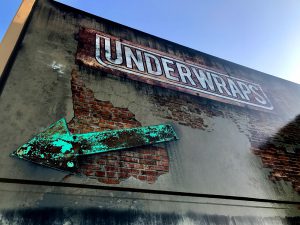
The wall wrap has also made Underwraps something of a local landmark. “It’s no longer just another wall of brick or concrete,” says Baumann, “but something entirely different you don’t expect to see in this area. People have been really impressed by all the attention to detail. Some come by just to take pictures.
“This is a very competitive business and you have to be on the edge in what you design. You’re continually challenged to come up with new and better designs for something that looks different than what everyone else is doing.”
By Mike Antoniak
All Photos: Underwraps


